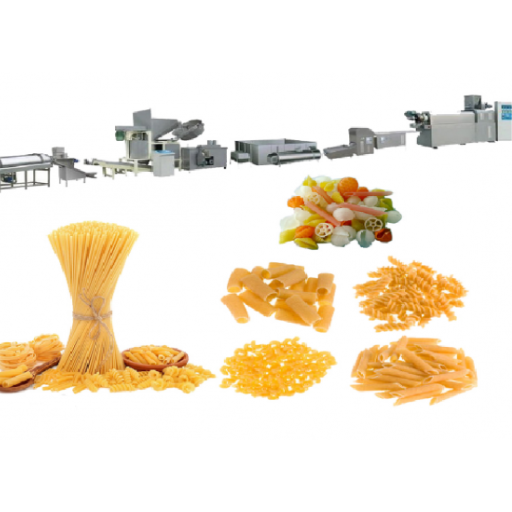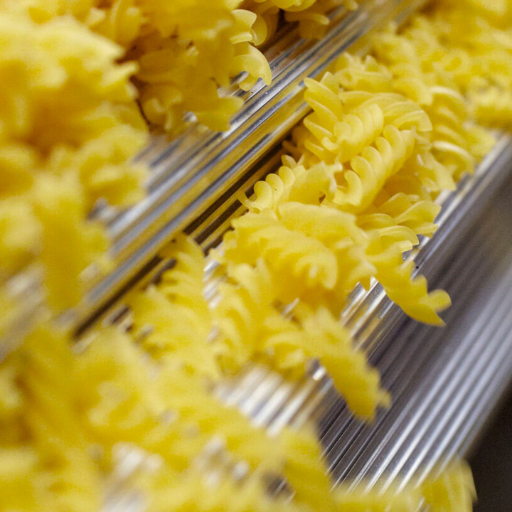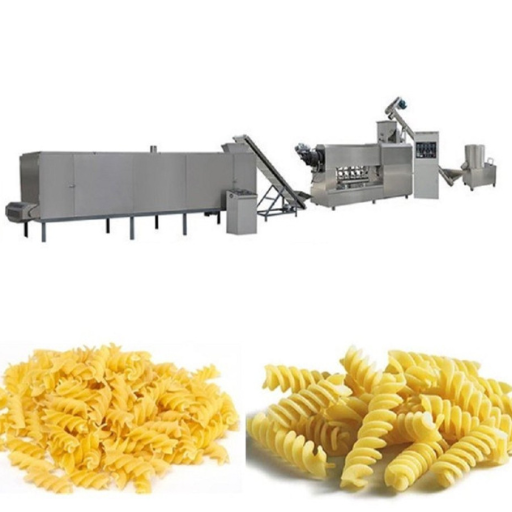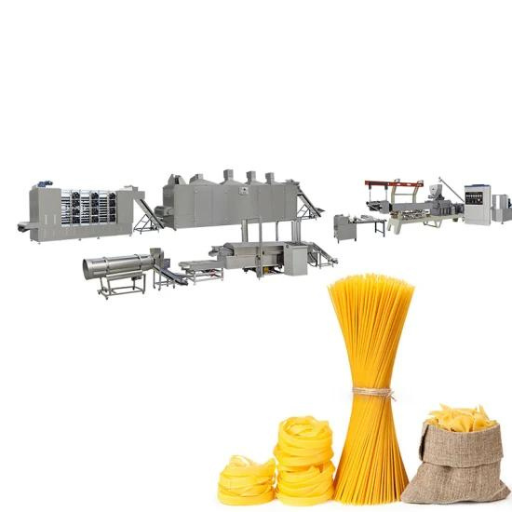Welcome to our blog where we delve into the fascinating world of pasta manufacturing, specifically focusing on the high-quality production of spaghetti pasta. In this series, we will explore the cutting-edge technologies and innovative solutions that drive the pasta production industry towards efficiency and excellence. From the raw materials selection to the intricate production processes and the stringent quality control measures, we aim to provide a comprehensive overview that highlights the meticulous effort involved in crafting superior spaghetti pasta. Whether you’re a food industry professional, a culinary enthusiast, or simply curious about how your favorite pasta reaches your plate, this blog will offer valuable insights and detailed information about the entire pasta production journey.
What is a Spaghetti Pasta Production Line?
Basic Principles of Understanding Pasta Production.
This spaghetti pasta production line is a complex assembly of machine and associated processes that are meant to convert raw materials, primarily semolina flour and water, into fine quality spaghetti. The stages include mixing, kneading, extrusion, drying and packaging. Semolina flour is mixed with water in order to form dough which is then kneaded until the desired texture is obtained. A die is used to press out the resultant dough into long strands of spaghetti or others shapes as required. It takes time for these strands to dry thoroughly; during this period it loses some moisture content that makes them edible without getting worse off soon. Eventually, dried spaghetti is cut into lengths sorted and put into packages ready for sale. This is in order to keep each one true to its nature.
The Place of Machinery in Spaghetti Production
To ensure uniformity correctness and a good final product throughout the process machinery plays a key role in modern making of spaghettis. Contemporary mixers and kneaders have been designed in such a way that they can accurately blend semolina flour together with water forming an even dough. The next step after blending involves using specialized dies on extruders so as to give the dough uniform shape and size thus producing standard strands of spaghetti. The automated drying systems maintain temperatures plus air moisture levels at optimum values for reducing the moistures without changing the pasta’s natural feeling. An efficient packaging system has also been incorporated which provides hygienic sorting and cutting mechanisms before sealing up the packets ready for transportation hence simplifying every stage involved in manufacturing process leading to decreased manual work while boosting overall output capacity for example through use of labor saving technologies.
Stages Involved In The Spaghetti Production Line
Mixing &Kneading:
- It begins by mixing semolina flour with purified water until it forms a mass called dough which will be worked further upon.
Extrusion:
- The kneaded dough passes through an extruder equipped with a specific die which shapes it into long strands of spaghetti. This step ensures that all the strands have the same shape and size.
Drying:
- The extruded spaghetti is allowed to dry under controlled temperature and humidity conditions. Moisture content in the pasta is reduced to increase its shelf-life and avoid spoilage during storage.
Cutting& Packaging:
- After drying, the long strands of spaghetti are cut, sorted according to their sizes then packed. Packaging machines that meet food safety requirements are used to handle, seal and prepare it for customer use.
How Does a Pasta Production Line Work?
Key Components of a Production Line
Mixers and Kneaders:
- Perfect dough texture is made possible through specialized mixers and kneading equipment. These machines make sure that semolina flour and water are well interconnected as well as kneaded to produce a desired consistency essential in the final product quality.
Extruders:
- The dough takes shape in various pasta forms courtesy of extrusion machines fitted with different dies. Long narrow even strands emerge when the dough is pushed through a die designed for spaghetti, this accuracy being important in maintaining product consistency and quality.
Dryers:
- Sophisticated drying systems play an integral part in reducing moisture content of the spaghetti. The pasta dryers have precise temperature and humidity controls that ensure even drying which prolongs its shelf life without interfering with its texture or taste.
Cutting and Packaging Machines:
- Cutting equipment automatically cuts dried spaghetti into specified lengths, whereas packaging machines perform hygienic sorting, and packing it into consumer friendly formats. These are hygiene conscious, efficient machines that guarantee cleanliness as well as safety of the product thus making it ready for market distribution.
Quality Control Systems:
- The production line has some quality control measures embedded within it, such as advanced systems for monitoring compliance at each stage. These include checking on dough consistency, uniformity of strands, correct drying and proper packaging in order to make sure that consumers get premium products alone.
A combination of these components results in an effective process of producing high-quality spaghetti by using traditional methods with modern technology.
Processing Techniques for High-Quality Pasta
High-quality pasta necessitates several processing techniques. Firstly, dough preparation plays a crucial role. This involves using durum wheat semolina mixed with water to obtain stiff dough which provides gluten structure needed by pasta. The gluten which develops when the dough is thoroughly kneaded will help give elasticity to the pasta once cooked.
Critical attention should be given to extrusion process. Through bronze or Teflon dies, the pasta dough is extruded into different shapes. Bronze dies are preferred for making high-quality pasta as it gives a rough texture that allows sauces to stick better. Temperatures must be carefully monitored during the extrusion process to prevent overheating which could spoil the pasta’s taste or texture.
Drying stage determines quality of pasta. Drying should be done gradually and under precise conditions, typical over lower temperatures and longer timeframes. This method ensures that pasta dries evenly without cracks thus maintaining its structure integrity. Proper drying also locks in the flavor of the paste and improves its storage stability.
These techniques combine age-old culinary practices with modern technology to create a tastier, stronger, more appealing product.
The Importance of Automation in Pasta Making
Automation has revolutionized pasta making improving efficiency, consistency and quality in this sector. Automated systems reduce difficulty in mixing dough by kneading it properly and ensure there is accurate control at every step of production. Stages like these help maintain high standards associated with premium pastas.
Automation significantly reduces human errors as well as contamination thereby increasing food safety levels. The automated drying systems also use advanced technology to regulate temperature and humidity at highly accurate settings; this is important for getting desired texture while also extending shelf life of pasta materials.
In addition to quality control, automation also offers scalable processes. It allows manufacturers to meet increased demands without sacrificing the integrity or taste of the pasta. This is very important in a competitive market where efficiency and product quality can differentiate brands.
All in all, automation combines traditional artisanal methods with modern technology ensuring that pasta-making techniques remain innovative and still maintain the authenticity and superiority typically associated with high-end pasta.
What Equipment is Essential for Spaghetti Production?
Main Machinery and their Roles
- Mixing Machine: This machine is used to combine the raw materials, especially flour and water into a uniform dough. This first step is important for achieving the right texture and elasticity that make excellent spaghetti.
- Extrusion Machine: After preparing the dough, it is passed through an extrusion machine in which it is forced out of different-shaped dies to form spaghetti. Not only does this process help shape the pasta but also aligns the gluten network making it firm and durable.
- Drying Machine: The freshly-formed spaghetti after extrusion is transferred to a drying machine. It carefully manages temperature as well as humidity to gradually dry out pasta by preventing cracks and maintaining its structure. Proper drying helps in extending shelf life as well as retaining final product’s texture.
Innovative Equipment for Improved Production
Innovations in machines have led to improved efficiency and quality in traditional pasta production by manufacturers. Some of the latest technological developments include:
- Automatic Flour Handling Systems: These systems are responsible for automatically storing, conveying, and measuring flour during preparation of dough with accuracy and consistency ensuring precision. They reduce human labor considerably while maintaining hygienic conditions around ingredients.
- Advanced Drying Technologies: Contemporary drying equipment with sophisticated sensors and control systems ensure proper temperature balancing throughout drying process at all times. Energy consumption can be reduced using such accurate drying processes thus minimizing chances of product degradation.
- Continuous Mixing and Extrusion Lines: These provide integrated solutions that continuously mix, knead and extrude dough hence making pasta production less complex. Such lines enhance throughput while keeping uniformity thereby reducing operational downtime yet producing consistent products.
Consequently, these modifications satisfy increased demand for superior quality spaghetti whose taste remains typical but whose production has become more efficient.
Maintenance of Pasta Production Machinery
For smooth operations on productivity grounds, good maintenance practices should be adhered to regarding pasta production machinery. Preventive maintenance entails regular checks as well as servicing meant at identifying any potential problem and resolving it before it causes major breakdowns. Lubrication should be done on a regular basis to keep the moving parts in order, inspect belts and gears for wear and tear as well as ensure correct performance of all sensors and control systems.
On the other hand, cleaning is also important which means that all equipment should be sanitized thoroughly in order to avoid contamination during production thus ensuring clean environments. Flour dust, dough residues and any other accumulation require specific cleaning procedures.
In particular, machines such as those meant for measuring ingredients and mixing need to be calibrated regularly so as to maintain accuracy and consistency during production. Moreover, proper handling skills including training of staff members on operation techniques and safety measures can enhance life span by reducing the chances of human errors.
Thereby, these maintenance practices minimize downtime while improving pasta product quality hence ensuring optimal efficiency on a safe production line.
How to Choose a Supplier for Pasta Production Lines?
Considerations for Picking your Supplier
You should evaluate a number of essential factors while choosing a supplier for pasta production lines in order to make an informed decision.
- Quality and Reliability: One important thing that you need to look out for when picking up a supplier is the quality and reliability of their equipment. Check certifications, read through some customer feedbacks and ask for case studies or testimonials that can prove what they say.
- Experience and Expertise: The suppliers who have spent many years in the industry of pasta production would be better suited to serve your specific requirements. Such suppliers have been able to establish themselves over time hence are more likely to meet your needs by providing you with bespoke solutions so as to improve your production process.
- Technical Support and After-Sales Service: For after sales operations, comprehensive technical support will always come handy. To solve this, ensure there is thorough training, ready access to spare parts, regular services on maintenance as well as prompt customer care for such issues.
- Customization Options: Every production facility is unique in its own ways. Therefore go for a supplier that has customization options thus enabling it to adapt their machinery into any specifics required by the exact product you want produced whether it’s scale, speed or even type of pasta itself.
- Cost and Return on Investment (ROI): In addition to buying cost price of the equipment including such things as installation, maintenance costs and running expenses must also be considered. Assess how machineries might improve productivity levels; decrease waste amounts while adding onto net income generated by the firm so as determine potential ROI from them.
- Delivery and Installation: Make sure delivery timelines are reliable throughout professional installation. Any delays may hamper your set schedules hence choose those vendors with track records of timely deliveries coupled with efficient installation processes.
By considering these aspects carefully you can find suppliers who not only satisfy immediate needs but also help achieve long-term organizational objectives.
The Best Spaghetti Manufacturing Equipment Suppliers
- LOYAL: LOYAL is a global leader in food processing technology and makes modern spaghetti production equipment that is efficient and long-lasting. These machines are highly customizable and thus, meet specific needs of production. For instance, excellent technical support, after-sales service like training, scheduled maintenance services as well as instant access to spares.
- ItalianPack: ItalianPack has been recognized for its innovative thinking in the area of pasta manufacturing including for Spaghetti making. The company’s machinery keeps original quality values while utilizing latest technological innovations necessary to elevate efficiency during the process. Customers love its reliable delivery, professionalism during installation procedures and total customer care package.
- Pavan Group: Pavan which forms part of GEA Group offers complete turnkey solutions for pasta production. It comes with versatile equipment tailored according to different scales of production and at various velocities hence high performing ones. To ensure minimal down time due to regular repairs, Pavan provides extensive technical support including detailed training programs as well as readily available spare parts.
What are the Latest Innovations in Spaghetti Pasta Processing?
Technological Advances in Pasta Machinery
In my capacity as a spaghetti manufacturer, I have observed numerous ground-breaking technological advances in pasta machinery during recent times. One of the key innovations is the computerization of production lines which results in high efficiency and reduced manual labor. Furthermore, there are now advanced sensors and AI driven systems capable of monitoring and adjusting the manufacturing process on real time basis guaranteeing uniform quality. Moreover, development of modern extrusion and drying technologies have seen improvements that result into better texture and taste but less energy consumption during final product making. These developments not only enable smooth running of operations but also promote sustainability objectives hence making modern pasta machines vital assets to both small and large-scale operations.
Innovative Techniques for Diverse Pasta Shapes
One interesting approach to pasta processing has been the use of 3D printing technology to make diverse shapes of pasta. Precise designs done by computers can be used to produce difficult to achieve intricate pasta forms that were not possible using traditional methods. Also, modular pasta dies and molds have been fitted onto production lines enabling quick transition between different shapes at an affordable price. This brings about greater flexibility in terms of range products with room for creativity that responds to varieties demanded by consumers who look forward towards customization being offered through such advancements so that finally manufacturers can make their products unique enough to attract more customers.
Trends in Pasta Packaging and Storage
There has been a significant shift towards sustainable packaging alternatives with respect to pasta over the last few years. One emerging trend is increased adoption of environmentally friendly materials like biodegradable or recyclable packages so as to reduce impacts on the environment. Companies are also considering smart packaging options that extend shelf life while keeping pastas fresh till when sold. For example, Modified Atmosphere Packaging (MAP) as well as vacuum sealing techniques have been employed so as maintain quality and flavor for long durations. Additionally, convenience has become a major consideration among consumers thus resealable bags and portional-sized packaging are becoming more popular. These developments not only address the growing preference for environmentally friendly practices but also improve overall consumer experience by offering convenient and eco-friendly choices.
Frequently Asked Questions (FAQs)
What grain is used to make premium quality spaghetti?
We make use of durum wheat in the manufacture of high-quality spaghetti pasta so as to ensure the best texture and taste.
Can the production line be customized for various types of long cut pasta?
Yes, our manufacturing solution can be tailor-made for different types of long cut pastas such as spaghetti, linguine and fettuccine.
How does the making machine ensure the pasta maintains a consistent diameter?
The making machines incorporate accurate extrusion technology and adjustment systems to guarantee normal width of each strand of long-cut pasta.
What is the production capacity of your spaghetti pasta line?
Production capacity varies with model and could be adjusted to meet specific output requirements which allow uninterrupted production throughout 24 hours a day.
Is the equipment made of stainless steel?
Definitely yes, all equipment in our pasta production line is made from high-grade stainless steel that guarantees sturdiness and food safety.
How does the industrial microwave in your system contribute to the pasta production?
The industrial microwave plays an essential role in ensuring exact drying and cooking procedures needed to keep its natural appearance.



















